Building a garden - layer upon layer
Denise Cleverley explains how to plan and plant a garden using the layered approach.
Planning and planting a garden can be likened to decorating a room. The big difference when designing with plants, of course, is that they’re living, growing things. We have to make our selection based on important things like soil, climate, wind, sunlight and growth rate. But once a list of suitable plants is settled on, we can proceed as we do with our interior furnishings, starting with the big stuff.
Trees, shrubs and hedges along with decking, pergolas and paving, can be likened to indoor furnishings; defining spaces and influencing how we move about. Just like furniture, trees and shrubs must be in proportion to the size of the garden and its surrounding architecture. Once the structure is in place, its time for embellishments. Accent plants, perennials and pots of flowering annuals are the equivalent of curtains, cushions and lamps.
Indoors and out, the art of layering is a great way to make the most of limited space. A garden built up in layers also creates micro-climates so that a wider range of plants can be grown.
The Canopy
Trees are a vital element of a garden. Without them, an outdoor space would appear bare and somewhat one-dimensional. Trees add height and visual weight, which helps balance the garden scene with other solid objects such as buildings. Evergreen trees are useful structural plants. Deciduous trees add seasonality with autumn colour and a sculptural winter framework. Both can add beautiful blossom and berry displays. Trees should be chosen according to the desired shape and form for a particular area, together with their ultimate proportions. They are among the first plants to be placed in the design process and form an anchor from which all other planting takes it cues. In small gardens, large growing shrubs, including rhododendrons, camellias and gordonia, can be trained into a small tree.
Best selling deciduous blossom trees
(* = good for small gardens)
- Albizia ‘Summer Chocolate’*
- Cercis ‘Forest Pansy’*
- Cornus ‘Eddie’s White Wonder’ *
- Magnolias: ‘Black Tulip’, ‘Felix Jury’, ‘Genie’, and ‘Vulcan’*
- Malus: ‘Jack Humm’* Prunus: ‘Accolade’, ‘Amanogawa’*, ‘Awanui’, ‘Falling Snow’*, ‘Shirotae’, ‘Schimidsu Sakura’*
Evergreen trees - NZ natives
- Cabbage Tree (Cordyline)*
- Hinau (Eleocarpus)
- Kowhai (Sophora)
- Lemonwood (Pittosporum eugenoides)*
- Makamaka (Ackama)
- Puka (Meryta)*
- Tree Daisy (Olearia) *
- Wineberry (Aristotelia)
Evergreen trees - exotics
- Australian Frangipani (Hymenosporum)
- Butterknife Bush (Cunonia) *
- Camellias *
- Magnolia ‘Little Gem’
- Magnolia 'Fairy Blush'*
- Michelia ‘Silver Cloud’
- Sydney Christmas Bush (Ceratopetalum)*
- Willow Myrtle (Agonis)
The Middle Storey
In the main, the middle storey is all about filling the spaces around trees and other structural planting, such as hedging and screening. Middle storey plants are generally between 1 – 2.5m high. Drawing a simple scale picture, or ‘elevation’, of a garden border, as viewed face-on, is a good idea to help visualise the desired effect. First, draw in the basic shapes of the main trees, hedges, screen planting and any hard landscaping features. Then, fill the gaps with varying shapes and forms to create an interesting composition. Vary heights and sizes of the plants, using mounding and rounded forms studded with columnar, pyramidal and narrow vertical forms. Look at the garden from various view points and consider areas where dramatic accent planting and strategic focal points, such as a sculpture, water feature or large ornamental urn, are best placed.
Areas under trees will require lower growing, shade tolerant plants. Open areas lend themselves to the inclusion of tall narrow plants to add vertical emphasis. Once you’re happy with your composition, compile a list of plants that fit the shapes. Choose only those plants suited to your climate, soil and style of garden. Narrow the selection further by choosing plants that sit amicably beside each other and create an interesting tapestry of varying foliage colours and textures. Be sure to repeat a few key plants to unify the overall picture.
Middle storey plants for sun
- Chinese Fringe Flower (Loropetalum)
- Conifers
- Corokia
- Hebe
- Lavender
- Marguerite daisy
- Plumbago
- Roses
- Snow tussock (Chionochloa)
- Spiraea
- Star magnolia (Magnolia stellata)
- Viburnum
Middle storey plants for shade
- Camellias
- Chinese Lantern (Abutilon)
- Daphne
- Fatsia
- Fuchsia
- Japanese Laurel (Aucuba)
- Lily of the valley shrub (Pieris)
- Rhododendron (including azaleas)
- Skimmia
- Sweet Box (Sarcococca)
Groundcovers
Complete the planting with a selection of dense groundcovers and other low growing plants. Design this layer in undulating swathes that curve in and out of the middle storey planting, to introduce a sense of movement through the border. As groundcovers are best viewed from above, fabulous effects can be created using large waves of contrasting coloured foliage. Use pockets of slightly taller growing strappy leafed plants, such as renga lily and dwarf flax, or the scalloped foliage of heucheras, to add exciting texture. Groundcover plants are not only an important finishing element; they also save you a lot of time by suppressing weeds!
Groundcovers for sun
- Californian lilac (Ceanothus)
- Cape daisy (Osteospermum)
- Carex and other grasses
- Coprosmas
- Heath (Ericas)
- Junipers
- Petunias
- Rock rose (Cistus)
- Roses
- Verbenas
Groundcovers for shade
- Button fern (Pellaea)
- Carpet bugle (Ajuga)
- Clivia
- Coral bells (Heuchera)
- Liriope
- Lungwort (Pulmonaria)
- Mondo grass (Ophiopogon)
- Renga lily (Arthropodium)
- Scented violets (Viola)
- Winter rose (Helleborus)
Accent Planting
Accent planting can be incorporated in any of the three main layers, or left until all other planting has been implemented. At this stage, it often becomes clearer where stand-alone accent plants are best situated to provide the greatest effect. Use accent planting as sentinels either side of steps or an entranceway, to highlight a feature such as an arbour or garden seat, or to draw the eye to a hidden corner of the garden. Choose plants with a distinct character such as dramatic foliage or an unusual form. Lifting accent plants up to eye level by planting them in tall urns is a useful way to further their dominance.
Dramatic foliage or form
- Agave
- Astelia
- Bamboo
- Cabbage trees (Cordyline)
- Cycad
- Flax (Phormium)
- Lancewood (Pseudopanax)
- Poor Knight’s lily (Xeronema)
- Puka (Meryta)
- Topiary plants
Design Tips
- Choose trees based on their ultimate size and shape and those that will remain in scale with the available space and surrounding buildings.
- Leave out the middle storey planting to create a simpler, more open effect. Use feature trees under planted with a selection of low ground covers, or one type of ground cover only for a more contemporary effect.
- Select key plants for each layer and repeat these throughout the garden to create unity and rhythm.
25-Oct-2022
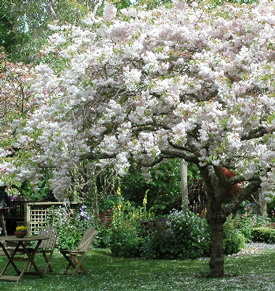
Prunus - flowering cherry
Prunus ‘Schimidsu Sakura’ makes a stand out feature tree, while clever layering in garden beds gradually lifts the eye in the Oakley Garden
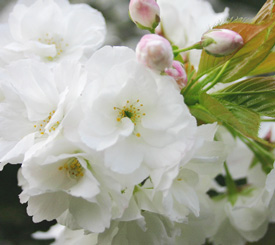
Prunus Shirotae
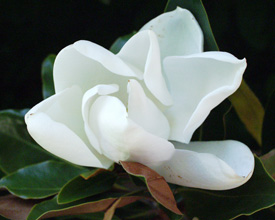
Magnolia Little Gem
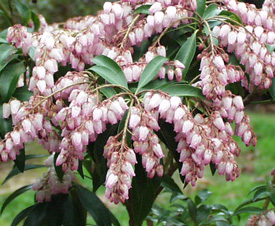
Pieris
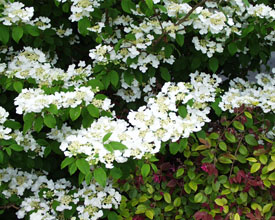
Viburnum
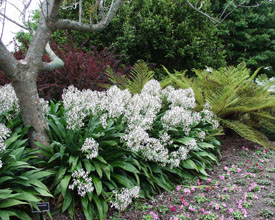
Renga lily (Arthropodium)
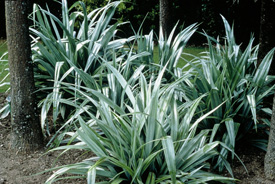
Astelia Silver Spear


